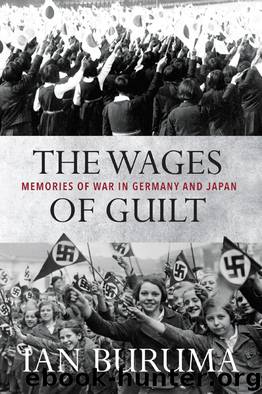The Wages of Guilt by Ian Buruma

Author:Ian Buruma [Buruma, Ian]
Language: eng
Format: epub
ISBN: 978-1-59017-859-1
Publisher: New York Review Books
Published: 2015-08-24T16:00:00+00:00
TOKYO
The law court in Nuremberg looks solid—indestructible almost—in a city that lacks solidity. The restored medievalism of the old town center gives the city a stagey atmosphere, as though Nuremberg were a mere backdrop to a historical fancy. The other solid building in Nuremberg is Albert Speer’s only remaining work, the stadium on the Zeppelin Field, where the annual Nazi Party rallies were held. It was too massive to blow up—the men’s lavatories are as big as average cinema halls—but it has not been maintained. Thick weeds sprout from the crumbling stone grandstands.
I asked an old man selling souvenirs (beer mugs, flags, knives) where the court building was. “You mean the place where they hanged our officers?” Yes, I said, that was the place. He gave me directions, but I lost my way. So I had to ask again at my hotel. The young woman behind the reception desk had no idea. Her supervisor, a bleached blonde in her fifties, came over to ask what I wanted. I repeated my question. Her lips curled. “What do you want to go there for?” she snapped. “There is nothing interesting to see. Why don’t you visit our Old City …” I said something about history. She turned away. “Foreigners,” she muttered.
The building is, as I said, solid, Wilhelmine, designed to impress. It is as pompous in its way as Speer’s stadium. Former judges stand on their stone pedestals like stern gods overlooking the Fürtherstrasse. Above the main entrance is a large frieze showing the various symbols of authority: tablets engraved with Roman numerals denoting the Ten Commandments, an open law book flanked by branches, and an ax projecting from a bundle of birch rods, the Roman insignia of penal power, later adopted by the fascists.
Although the Japanese, too, went in for Wilhelmine grandeur (perhaps more in the colonies than in Japan itself), there is nothing in Tokyo like the Nuremberg law court. There were more than 2,000 war crimes trials held by Allied tribunals in Japan, Southeast Asia, and other Asian and Pacific locales. But the building where the International Military Tribunal of the Far East sat in judgment of the 28 Japanese wartime leaders from 1946 until the end of 1948, the so-called Class A defendants, was a former military academy, which had served as the Japanese Army headquarters at the end of the war. The auditorium had been hastily transformed into a wood-paneled courtroom, lit by blinding klieg lights, which reminded Joseph Keenan, the chief prosecutor, of a Hollywood film studio. Later, the building was demolished to make way for a new town hall.
There was, however, another, more poignant building associated with the trial: Sugamo prison. Here it was, in the “death house,” that six generals and one civilian were hanged in the middle of a December night in 1948, after being sentenced by the Allied judges of the Tokyo tribunal. Sugamo prison, built in imitation of nineteenth-century European jails, was torn down in the 1970s. On its site—against the
Download
This site does not store any files on its server. We only index and link to content provided by other sites. Please contact the content providers to delete copyright contents if any and email us, we'll remove relevant links or contents immediately.
The Radium Girls by Kate Moore(10935)
The Templars by Dan Jones(4202)
100 Deadly Skills by Clint Emerson(4098)
Rise and Kill First by Ronen Bergman(4032)
The Doomsday Machine by Daniel Ellsberg(3744)
The Rape of Nanking by Iris Chang(3537)
Killing England by Bill O'Reilly(3470)
Hitler in Los Angeles by Steven J. Ross(3457)
Stalin by Stephen Kotkin(3099)
12 Strong by Doug Stanton(3066)
Hitler's Monsters by Eric Kurlander(2742)
Darkest Hour by Anthony McCarten(2657)
Blood and Sand by Alex Von Tunzelmann(2617)
The Art of War Visualized by Jessica Hagy(2428)
Hitler's Flying Saucers: A Guide to German Flying Discs of the Second World War by Stevens Henry(2308)
The Code Book by Simon Singh(2223)
The Second World Wars by Victor Davis Hanson(2140)
Babylon's Ark by Lawrence Anthony(2079)
Tobruk by Peter Fitzsimons(2070)
